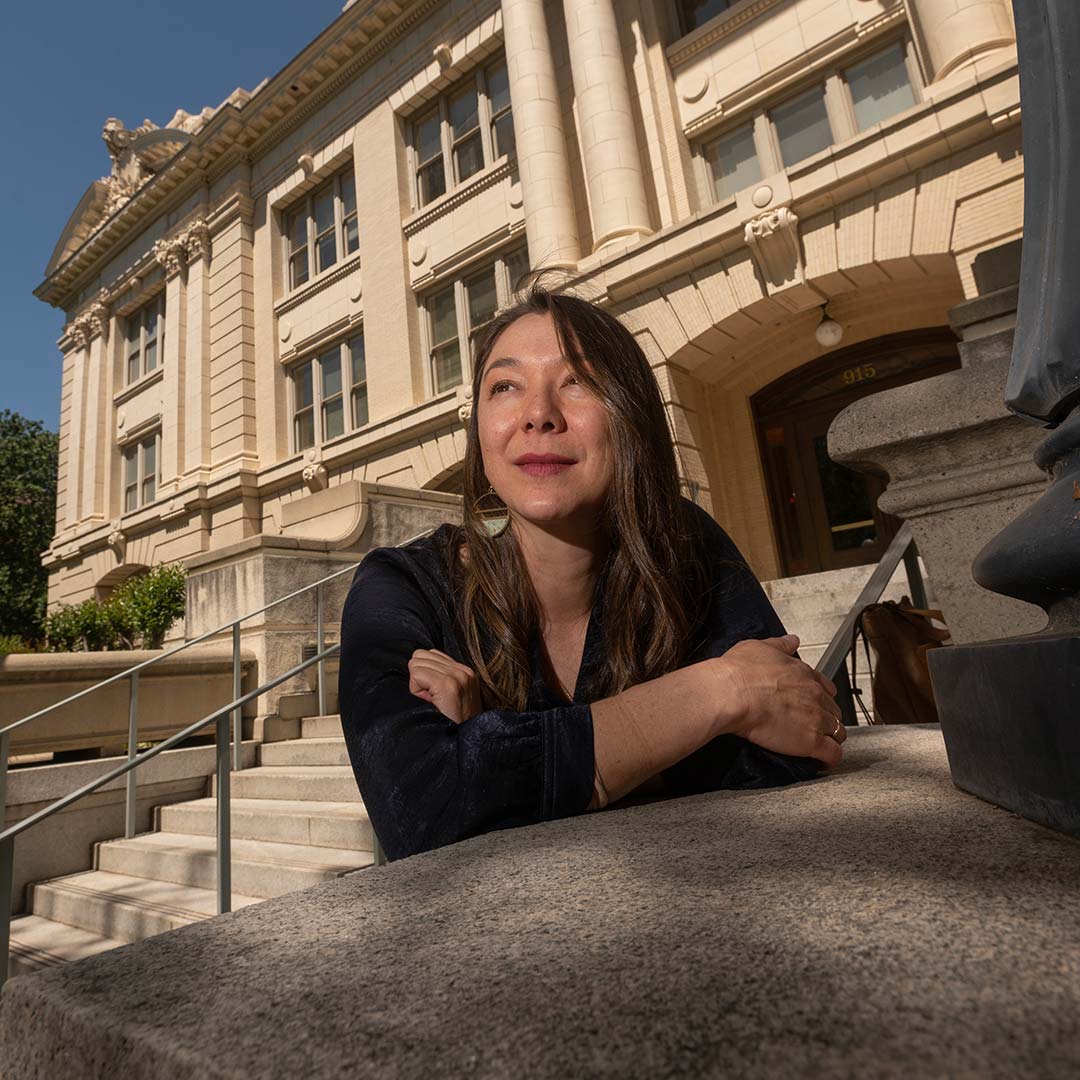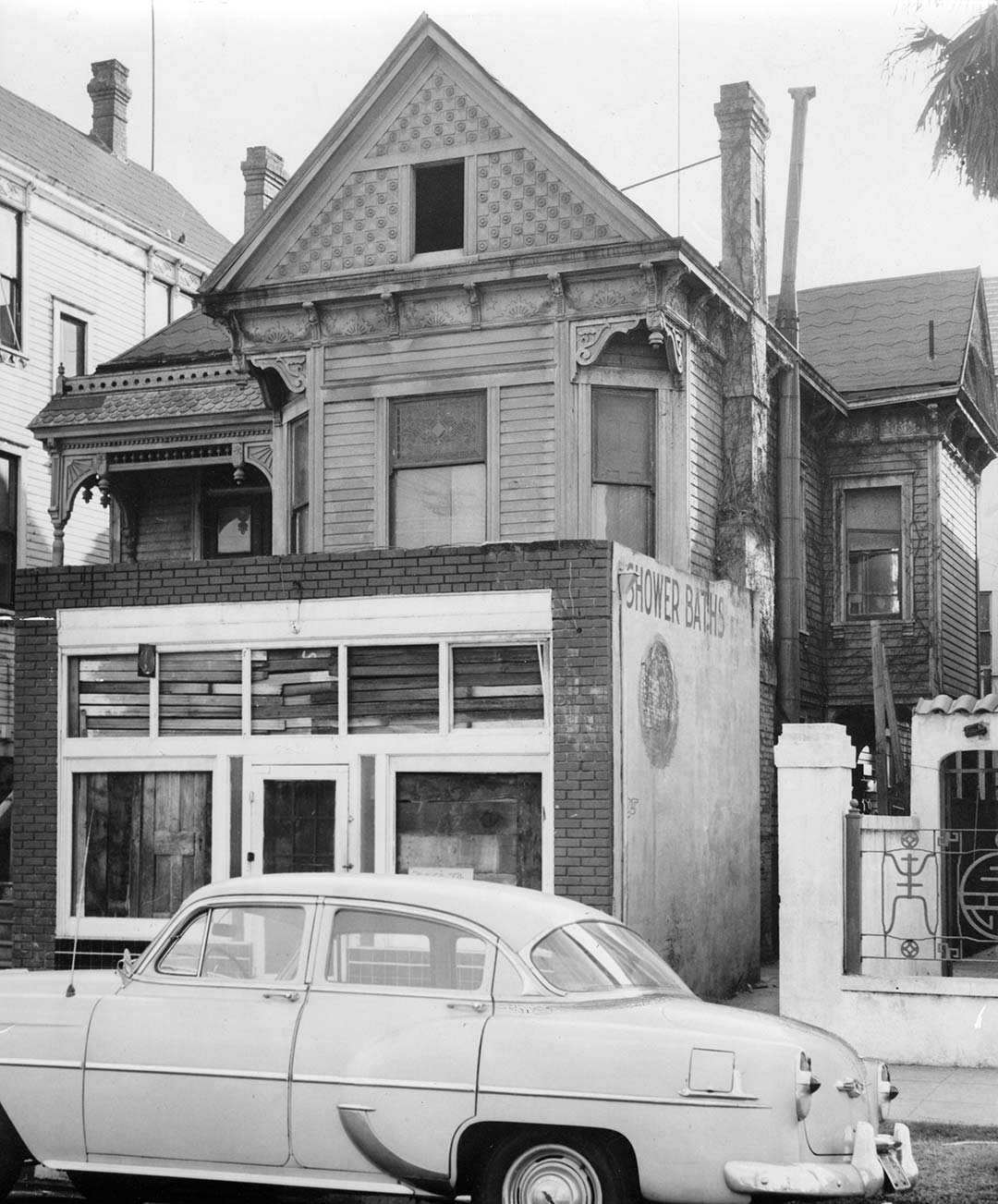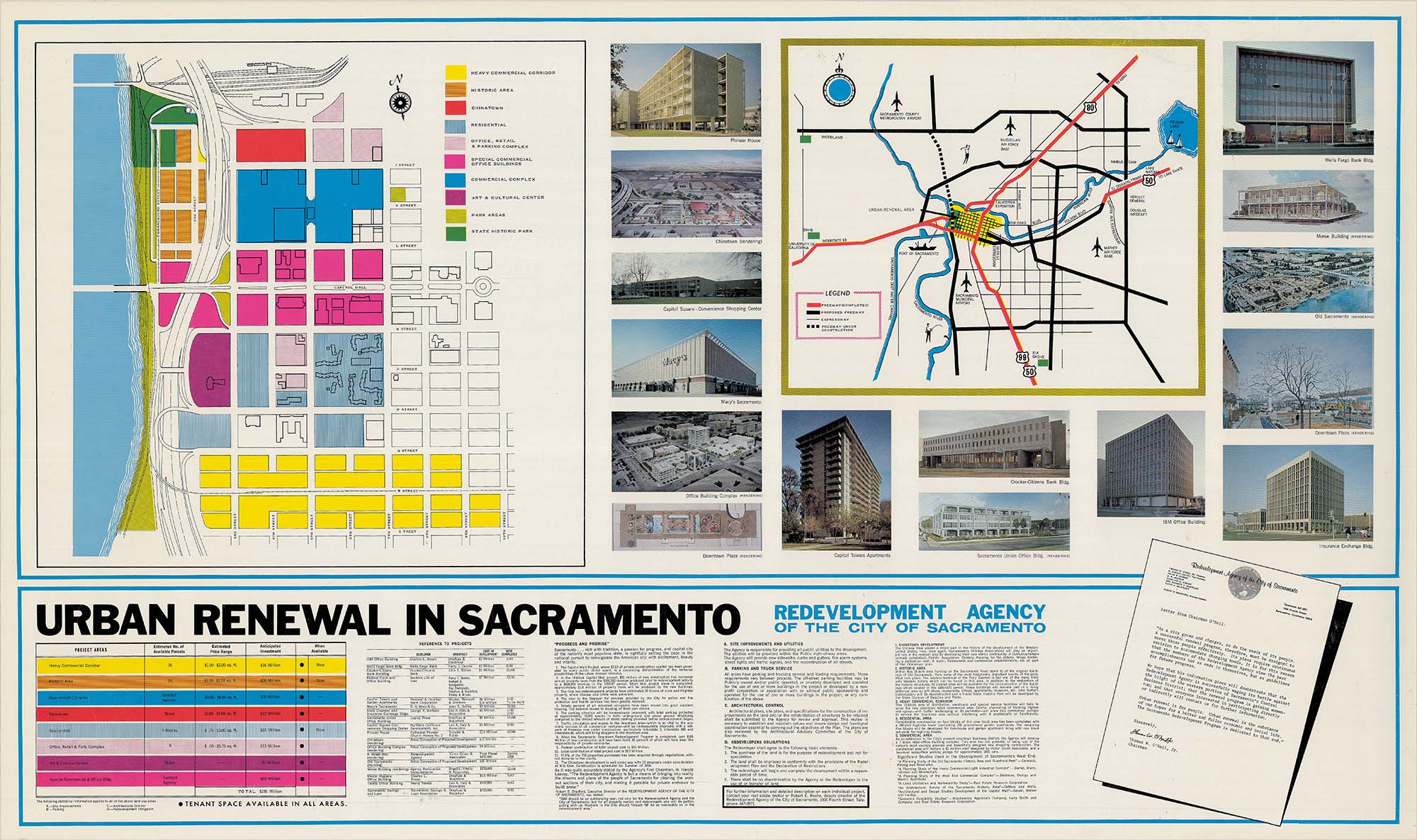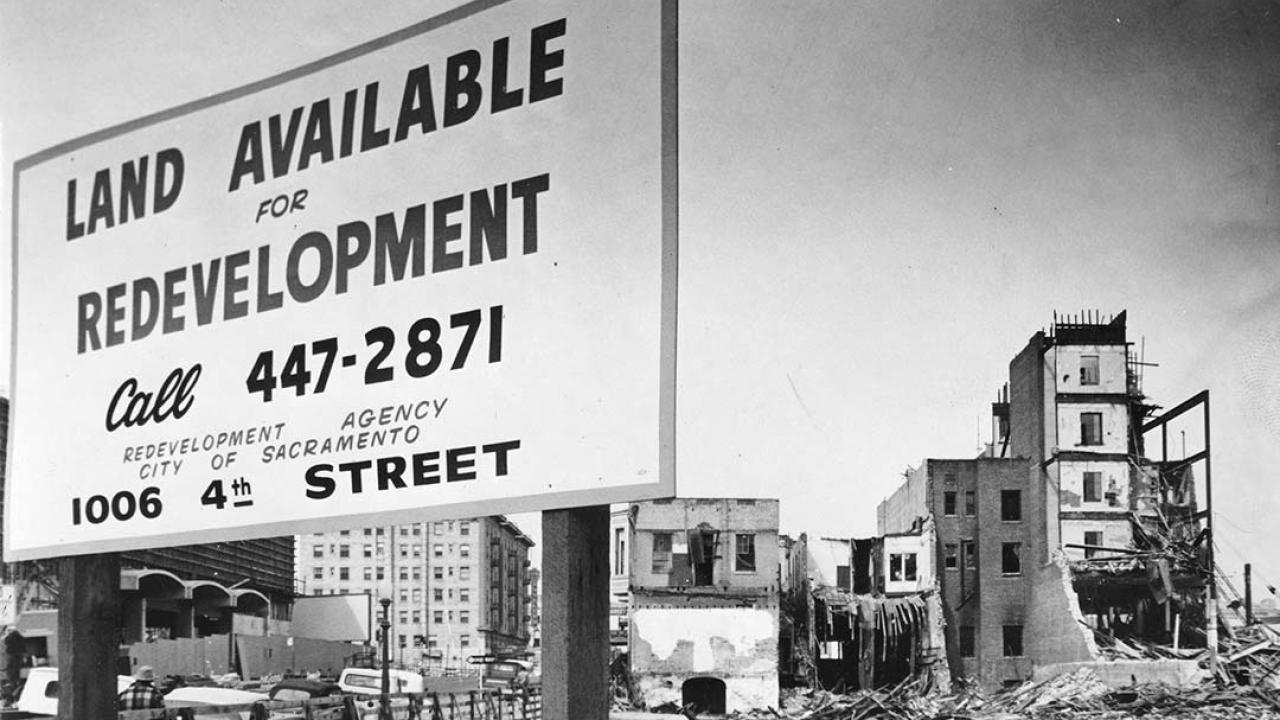History graduate students at UC Davis are investigating past discrimination against the Black community in Sacramento during the 1950s and beyond. With direction from Professor Gregory Downs, and in partnership with the city of Sacramento and the Greater Sacramento Urban League, they seek to answer the question: What could reparations look like?
Downs, a scholar of the 19th century American South, and his students are examining postwar redevelopment efforts— then called “slum clearance” — in Sacramento that forced a thriving Black community out of the city’s old West End, the neighborhood that now encompasses the Capitol Mall and Old Sacramento. They delved into the archives of a civil-rights lawyer, court cases, newspapers, and more, reporting their findings to Kelly Fong Rivas, senior advisor to Sacramento Mayor Darrell Steinberg; and Troy Williams, chief impact officer at the Greater Sacramento Urban League.

The research project, surprisingly, grew out of a chance connection born of Downs’ commitment to engaging his undergraduate students. When he arrived at UC Davis in 2015, Downs quickly realized that the students in his introductory courses didn’t see the connection between the Civil War era he specializes in and their home region, so he rethought his teaching.
“Students were familiar with things like the Gold Rush, which I think is somewhat of an oversimplified founding myth, or the Oregon Trail,” he said. “With the help of colleagues who are great scholars of the West, I started to embed more information about how California was central to the Civil War, which led to a transformation of Black rights. A lot of those things really hit home with students.”
One of those undergraduates happened to have an internship with Sacramento’s mayoral office, said Downs. “One day he contacted me and said, ‘Can I put you in touch with my boss?’ He had been in a meeting where Kelly Fong Rivas was discussing a goal to make a rigorous, serious effort at municipal reparations rooted in a clear study of history,” said Downs.
That chance connection led to a successful application for grant funding from the UC Davis Public Impact Research Initiative and kicked off a cooperative effort that hopes to transform Sacramento’s historically marginalized communities.


Toward reparations — and repairing community trust
Rivas, previously chief of staff, became the mayor’s racial equity advisor following the reckoning after George Floyd’s murder in 2020. At the time, then–Los Angeles Mayor Eric Garcetti formed a coalition to push cities to make reparations to marginalized communities. “Our commitment to develop municipal reparations started with Mayors Organized for Reparations and Equity,” said Rivas. “That focused on Black communities and finding an area within the control of local government.”
Models for municipal reparations already existed, notably in Evanston, Illinois, where a city resolution established a reparations fund in 2019; in 2021, the city began payments to redress past housing discrimination. As of August 2023, the program had disbursed more than $1 million.
Rivas attended a summit in Evanston and “learned some promising practices,” she said. “They had done deep research through newspaper files, any data available, and also interviews with elders in the community, to craft what they ultimately passed.”
The Evanston model underscored the need for solidly researched footing for community repair, but it also pointed toward arenas such as housing discrimination. “When we started to look at the city of Sacramento’s history, natural places to look were areas of redevelopment,” Rivas said. “We became interested in the West End because there’s such a rich history there, as well as documentation thanks to Nathaniel Colley.” Colley, the first African American lawyer in Sacramento, brought civil rights suits against the city, and his papers became a trove for researchers.
Finding an issue solely within local government control was key to shaping the research project. The city of Sacramento redeveloped the West End on its own; other redevelopment efforts (such as those for building interstates) also caused significant harms, but involving other government agencies would cloud questions of responsibility. Though the scope might seem modest, Downs noted a clear focus gives the project a better chance of success.
“It’s important that local governments show that you can do something that’s not just symbolic,” said Downs. “We need models that work.”
As crucial as moving toward reparations, Rivas added, is building trust with marginalized communities. “In understanding how to create a reparative process, we can’t just look at an end product,” said Rivas, who added that reparations can be a loaded term. “Everybody jumps to compensation. How much? It creates a distraction. [Payments] are a piece of it, but this work is that of empowering community and centering community that was harmed.”

Including community voices
Community involvement has come through the crucial role of Troy Williams, who has a Ph.D. in human ecology and trained in community-based participatory research. He became part of the project in an unusual way: as an external reviewer for UC Davis grant funding.
“When I was reviewing proposals, I came across Dr. Greg Downs’ proposal and it just jumped off the pages,” said Williams. “I was amazed at what he and his graduate students had already accomplished. I thought, we have to figure out how to work with this gentleman, because he wasn’t asking for much money.”
Under Williams’ auspices, the Urban League offered to co-fund the proposal, which turned the project into a coalition with Rivas, Williams and Downs. “It’s extremely important for a rights organization to ensure that the voices that need to be at the table are present,” said Williams. Additional funding also offered a chance to expand the research to the underserved north Sacramento neighborhood of Del Paso Heights, where the Urban League is headquartered and where many displaced West Enders resettled, only to suffer further discrimination.
“A lot of those families still live in these communities,” said Williams. “If we can assist these folks and correct the damage of displacement and losing generational wealth, that would be a great thing to be part of, as well as being part of the larger reparations conversation in California.”
Both the initial grants and continued funding have been invaluable at these preliminary stages of the project, which is a mayoral initiative, not a formal mandate. “I’m the only staff member officially [on this initiative], and I was kind of shocked to get funding out of the city budget for racial equity,” said Rivas. “I’ve been trying to be frugal and scrappy and let the community decide what most of that funding should go toward. So the grant with Greg and being able to work with the student [researchers] has been amazing.”
Rivas, Williams and Downs said they hope the project will lead to a formal reparations initiative but agree that building relationships is worth the time. “We’ve learned to move at the speed of trust with community,” said Rivas.
Added Williams, “What’s so encouraging about the work is that they are really trying to get at systems-induced trauma. One thing that I love about working about historians, they really want to get the facts.”

Research nuts and bolts
Initially, graduate students used attorney Nathaniel Colley’s papers to investigate the impact of West End redevelopment, presenting their findings to Rivas, Williams and Downs regularly through meetings and formal reports.
Even with a big archival cache, tracing direct historical impacts wasn’t easy, said Taylor Black, a fifth-year graduate student who worked on the project’s first phase: “Surprisingly, there weren’t a lot of specific stories referenced in the sources, which is part of the struggle. It’s striking how many of the actual physical buildings where these businesses were no longer exist because they were physically destroyed. The sources are scant.”
Colley’s papers, for instance, reference 32 clients he was representing in lawsuits related to redevelopment, but don’t name the individuals — and seeking them in court records, stored on 1,000-page microfiches, led to another roadblock: court staff who didn’t have time to comb through hundreds of pages of files.
Such challenges are part of historical work, said Downs: “In an ideal world, you could really have a story that explodes across the map and into the present day. But some of those records can be challenging to trace, including things like figuring out where a business owner or property owner went” — especially if they had a relatively common name.
As the grant has been renewed and work has continued, the scope of research has grown. Students Chantal Walker, Omari Averette-Phillips and Sareena Crawford have looked at the neighborhood of Del Paso Heights, reflecting both the inclusion of community voices and the complex and contingent harms the Black community experienced.
In Williams’ community, this history is very much alive: “When I have spoken to some of my colleagues or community members about some of the findings, they’ll say, ‘Oh, my gosh, I know him. That’s my uncle,’” said Williams. “I spoke to our former senior director of partnerships and mentioned a name [from] the research, and he said, ‘Oh, I know him well. He was a member of my church.’”
The historical research is already having an impact. Walker’s research for instance, helped demonstrate institutional inequity in Del Paso Heights, long a banking desert. “The research that Chantal put into place absolutely assisted us,” said Williams. “Not only have we included it in our impact report, but we are speaking with congresspeople and potential investors for developing that area.”
Students also benefit, gaining experience in archival research and public history. “The Urban League, the mayor’s office and Dr. Downs are all super open and receptive to what we want to do as researchers,” said Crawford. “I feel incredibly grateful to be part of this project. I am a Black woman and I am from Utah, and even the concept of the mayor’s office considering reparations is huge.”
Black, who specializes in race, religion and imperialism in the 19th-century America, agreed: “I’m required to become a specialist and write a dissertation that’s very specific, but I very much see myself as an intellectual-slash-teacher, teaching a much broader set of questions,” he said. “This [project] is in line with that. Public history matters a lot.”

An uncertain but promising future
Downs said he imagines many possible outcomes for this project, including making this history publicly available. “I would love to think about how you could make a digital history site where people could look at the overlay of the map of the old West End and be able to click and see who’s there, and then flip to the map post-redevelopment,” said Downs.
Although continued research is funded for summer 2024, the city’s future role is uncertain. A new mayor (to be elected in November, in a runoff) will take office in December 2024, and whether to move toward reparations will be in the new administration’s discretion. Rivas will leave her position with the outgoing mayor.
Regardless of what form future initiatives take, Rivas sees the research partnership with UC Davis and the Urban League as a resounding success. Grant funding “has been incredibly meaningful,” she said. “Creating that space for community and coalition building was a big piece of the work, and we’ve done that front-end research that’s needed historically.”
“This is really deep, hard systems-level change [of] unwinding generational trauma,” Rivas added. “It won’t be done with a single piece of legislation or a single program or a single ribbon cutting. It will take many years for repair to take hold, and it starts with this type of relationship building.”
